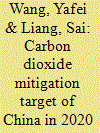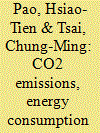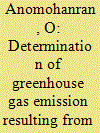|
|
|
Sort Order |
|
|
|
Items / Page
|
|
|
|
|
|
|
| Srl | Item |
| 1 |
ID:
122718


|
|
|
|
|
| Publication |
2013.
|
| Summary/Abstract |
China proposed a CO2 mitigation target in 2020 to deal with anthropogenic global climate change. Chinese policy makers mainly focus on three factors comprising consumption structure changes, energy technology development, and new energy increments. In addition, sectoral CO2 reduction is increasingly concerned in the world. Thus, it is significant to investigate integrated impacts of three factors to China's CO2 mitigation target as well as to identify key economic sectors for achieving this target. In this study, energy demand and CO2 emission in 2020 are predicted. Five scenarios are generated to illustrate the contributions of three factors. In addition, twelve key economic sectors for reducing energy demand and CO2 emission are identified from both production and final demand perspectives. Under integrated impacts of three factors, China's CO2 intensity per unit gross domestic product in 2020 will decrease by about 43.9% in 2020 than 2005 level. In the short term, China's CO2 mitigation will be highly dependent on energy technology development. In the long term, it will mainly rely on reshaped consumption structure changes and new energy development. In addition, China's future policies should focus on 12 identified key economic sectors.
|
|
|
|
|
|
|
|
|
|
|
|
|
|
|
|
| 2 |
ID:
101505


|
|
|
|
|
| Publication |
2010.
|
| Summary/Abstract |
This paper examines dynamic causal relationships between pollutant emissions, energy consumption and output for a panel of BRIC countries over the period 1971-2005, except for Russia (1990-2005). In long-run equilibrium energy consumption has a positive and statistically significant impact on emissions, while real output exhibits the inverted U-shape pattern associated with the Environmental Kuznets Curve (EKC) hypothesis with the threshold income of 5.393 (in logarithms). In the short term, changes in emissions are driven mostly by the error correction term and short term energy consumption shocks, as opposed to short term output shocks for each country. Short-term deviations from the long term equilibrium take from 0.770 years (Russia) to 5.848 years (Brazil) to correct. The panel causality results indicate there are energy consumption-emissions bidirectional strong causality and energy consumption-output bidirectional long-run causality, along with unidirectional both strong and short-run causalities from emissions and energy consumption, respectively, to output. Overall, in order to reduce emissions and not to adversely affect economic growth, increasing both energy supply investment and energy efficiency, and stepping up energy conservation policies to reduce unnecessary wastage of energy can be initiated for energy-dependent BRIC countries.
|
|
|
|
|
|
|
|
|
|
|
|
|
|
|
|
| 3 |
ID:
113478


|
|
|
|
|
| Publication |
2012.
|
| Summary/Abstract |
Greenhouse gas emission and its effect on the environment have gained the attention of researchers, environmentalists and policy makers in recent times. This is as a result of its devastating impact both on the climate and the environment. Records of natural gas produced and natural gas flared in Nigeria from 1999 to 2009 were collected and subjected to descriptive analysis as well as the Reference Approach method of greenhouse gas determination. Result showed that the total gas produced in Nigeria from 1999 to 2009 was 502 million cubic meters while 237 million cubic meters, representing 47% was flared. Result also showed that the total gas flared reduced from 23 million cubic meters in 1999 to 14 million cubic meters in 2009. Result indicates that the total quantity of carbon dioxide emitted between 1999 and 2009 was found to be 457 million metric tons which is 23.1 percent when compared with the global value of 1979 million metric tons. Result further indicates that an estimated sum of 11 billion dollars is lost annually to gas flaring in Nigeria. It is recommended that the government should put in place appropriate and implementable policies to end gas flaring in Nigeria.
|
|
|
|
|
|
|
|
|
|
|
|
|
|
|
|
| 4 |
ID:
098210


|
|
|
|
|
| Publication |
2010.
|
| Summary/Abstract |
In this paper, Shanghai's CO2 emissions from 1995 to 2006 were estimated following the IPCC guidelines. The energy demand and CO2 emissions were also projected until 2020, and the CO2 mitigation potential of the planned government policies and measures that are not yet implemented but will be enacted or adopted by the end of 2020 in Shanghai were estimated. The results show that Shanghai's total CO2 emissions in 2006 were 184 million tons of CO2. During 1995-2006, the annual growth rate of CO2 emissions in Shanghai was 6.22%. Under a business-as-usual (BAU) scenario, total energy demand in Shanghai will rise to 300 million tons of coal equivalent in 2020, which is 3.91 times that of 2005. Total CO2 emissions in 2010 and 2020 will reach 290 and 630 million tons, respectively, under the BAU scenario. Under a basic-policy (BP) scenario, total energy demand in Shanghai will be 160 million tons of coal equivalent in 2020, which is 2.06 times that of 2005. Total CO2 emissions in 2010 and 2020 in Shanghai will be 210 and 330 million tons, respectively, 28% and 48% lower than those of the business-as-usual scenario. The results show that the currently planned energy conservation policies for the future, represented by the basic-policy scenario, have a large CO2 mitigation potential for Shanghai.
|
|
|
|
|
|
|
|
|
|
|
|
|
|
|
|
| 5 |
ID:
098540


|
|
|
|
|
| Publication |
2010.
|
| Summary/Abstract |
In this paper, Shanghai's CO2 emissions from 1995 to 2006 were estimated following the IPCC guidelines. The energy demand and CO2 emissions were also projected until 2020, and the CO2 mitigation potential of the planned government policies and measures that are not yet implemented but will be enacted or adopted by the end of 2020 in Shanghai were estimated. The results show that Shanghai's total CO2 emissions in 2006 were 184 million tons of CO2. During 1995-2006, the annual growth rate of CO2 emissions in Shanghai was 6.22%. Under a business-as-usual (BAU) scenario, total energy demand in Shanghai will rise to 300 million tons of coal equivalent in 2020, which is 3.91 times that of 2005. Total CO2 emissions in 2010 and 2020 will reach 290 and 630 million tons, respectively, under the BAU scenario. Under a basic-policy (BP) scenario, total energy demand in Shanghai will be 160 million tons of coal equivalent in 2020, which is 2.06 times that of 2005. Total CO2 emissions in 2010 and 2020 in Shanghai will be 210 and 330 million tons, respectively, 28% and 48% lower than those of the business-as-usual scenario. The results show that the currently planned energy conservation policies for the future, represented by the basic-policy scenario, have a large CO2 mitigation potential for Shanghai.
|
|
|
|
|
|
|
|
|
|
|
|
|
|
|
|
| 6 |
ID:
133265


|
|
|
|
|
| Publication |
2014.
|
| Summary/Abstract |
To better understand the role of sustainable urban development in greenhouse gas (GHG) mitigation, this study examines the paths by which urban form influences an individual household×s carbon dioxide emissions in the 125 largest urbanized areas in the U.S. Our multilevel SEM analyses show that doubling population-weighted density is associated with a reduction in CO2 emissions from household travel and residential energy consumption by 48% and 35%, respectively. Centralized population and polycentric structures have only a moderate impact in our analyses. Given that household travel and residential energy use account for 42% of total U.S. carbon dioxide emissions, these findings highlight the importance of smart growth policies to build more compact and transit friendly cities as a crucial part of any strategic efforts to mitigate GHG emissions and to stabilize climate.
|
|
|
|
|
|
|
|
|
|
|
|
|
|
|
|
| 7 |
ID:
132645


|
|
|
|
|
| Publication |
2014.
|
| Summary/Abstract |
China achieved an energy savings of 67.5 Mtce in the building sector at the end of the 11th Five-Year Plan and set a new target of 116 Mtce by the end of the 12th Five-Year Plan. In this paper, an improved bottom-up model is developed to assess the carbon abatement potential and marginal abatement cost (MAC) of 34 selected energy-saving technologies/measures for China×s building sector. The total reduction potential is 499.8 million t-CO2 by 2030. 4.8 Gt-CO2 potential will be achieved cumulatively to 2030. By 2030, total primary energy consumption of Chinese building sector will rise continuously to 1343 Mtce in the reference scenario and 1114 Mtce in the carbon reduction scenario. Total carbon dioxide emission will rise to 2.39 Gt-CO2 and 1.9 Gt-CO2 in two scenarios separately. The average carbon abatement cost of the aforementioned technologies is 19.5 $/t-CO2. The analysis reveals that strengthening successfully energy-saving technologies is important, especially for the residential building sector. The central government×s direct investments in such technologies should be reduced without imposing significant negative effects.
|
|
|
|
|
|
|
|
|
|
|
|
|
|
|
|
|
|
|
|
|